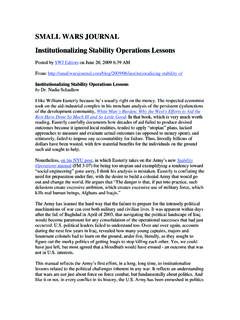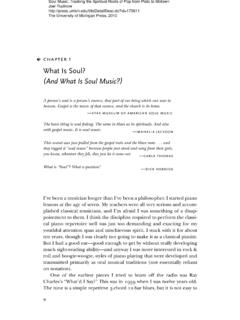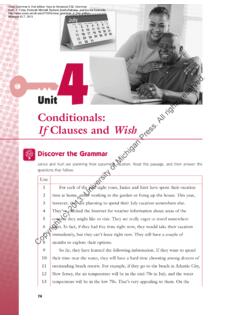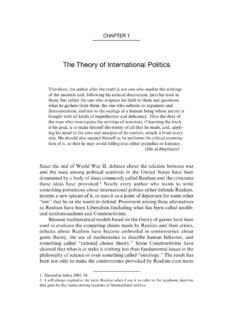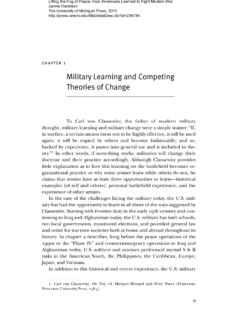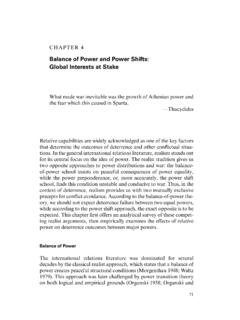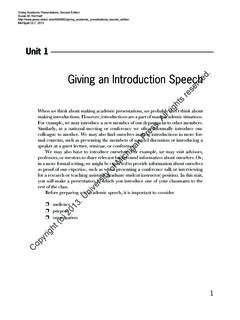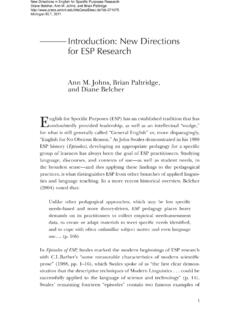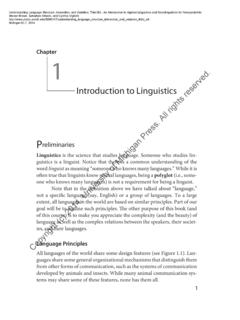Transcription of Chapter 2 Theories of Participation and High-Intensity ...
1 Chapter 2 Theories of Participationand High-Intensity Participationjin the previous Chapter we examinedthe changes to the Britishparty system in the last fty years since the APSA report on the responsi-ble party model. We have suggested that these changes have implicationsfor High-Intensity Participation in political parties. The picture is, how-ever, mixed both at the level of the electorate and in relation to partymembers. There is some evidence, on the one hand, of partisan dealign-ment but also, on the other, of party strength, as demonstrated by the out-come of the 2001 general election. In that election the three major par-ties took 94 percent of the vote in Great Britain (British Election Studywebsite, 2001). It is interesting to note that only one independent MPwas elected to the House of Commons in , while there isevidence of a postwar decline in the party membership, in the strength ofparty identi cation in the electorate, and in the share of the vote of thetwo major parties, Britain s political system is nonetheless still dominatedby parties.
2 British government continues to be very much party , the two major parties raise and spend more money than everbefore, and as we have seen they are both in the process of reviving theirgrass roots membership and revitalizing their party organization. At thesame time there are clear centralizing tendencies within the parties thathave served to move the system away from the original responsible partymodel, even if the new system cannot be accurately described as a cartelparty model. Clearly, there are challenges to the parties in Britain, butthey still dominate the political landscape. So is the British party system35in decline or merely in transition? And what do these changes mean forhigh-intensity Participation ?To answer these question we need a coherent theory of political par-ticipation. In the absence of such a theory, the meaning of the evidenceis ambiguous.
3 If we do not know why people support a party by voting forit, joining it, and in some cases working many hours for it, then we areunlikely to be able to determine what the developments in the party sys-tem discussed in Chapter 1 mean for High-Intensity political participationin the future. The problem of providing such a theoretical explanation is made allthe more acute by the fact that the dominant model of political partici-pation in political science the civic voluntarism model (see Verba,Schlozman, and Brady 1995) predicts that Participation in the Britishparty system should be increasing, not declining, over time. This predic-tion is discussed more fully later in this Chapter , but in the light of the fallin turnout in the 2001 general election compared with its predecessor (see g. ) and the evidence on party activism discussed later, there is clearlya problem with this model.
4 A similar problem occurs in relation to rational choice accounts ofpolitical Participation . As is well known, rational choice theory hasdif culty explaining why anyone should vote in an election or join andbecome active in a political party. On the face of it, in this theoreticalframework the British party system should not be in decline because itshould not have developed in the rst place! Obviously, there is animportant task of theoretical clari cation to be undertaken before theevidence can be weighed and before the question as to what the changesin the party system mean for High-Intensity Participation can Chapter is devoted to examining the alternative theoretical expla-nations of political Participation that exist in the literature. The task is toevaluate their theoretical coherence, the empirical predictions they makeabout citizen involvement in politics, and their success or otherwise inexplaining party support and High-Intensity Participation .
5 The aim is toexamine the strengths and weaknesses of each approach, before estimat-ing them empirically in Chapter 3. This Chapter prepares the groundworkfor an analysis that identi es the best models for explaining high-inten-sity Participation in the Labour and Conservative are ve theoretical approaches or models of political participa-36high-intensity participationtion that have developed in the political science literature. They can bedescribed in abbreviated form as the civic voluntarism model, the rationalchoice model, the social-psychological model, the mobilization model,and the general incentives model. Each is in uenced by a differentresearch tradition, and we examine them in turn. The Civic Voluntarism Model jThe most well-known and widely applied model of political participationin political science was originally referred to as the resources model andhad its origins in the work of Sidney Verba and Norman Nie (1972) intheir in uential research on Participation in the United States.
6 It wassubsequently applied by the authors, their collaborators, and others toexplain Participation in other countries, including Britain (Verba, Nie,and Kim 1978; Barnes and Kaase 1979; Parry, Moyser, and Day 1992;Verba et al. 1993). The central ideas of the civic voluntarism model ofparticipation are captured in the following quote:We focus on three factors to account for political activity. We suggestedearlier that one helpful way to understand the three factors is to invertthe usual question and ask instead why people do not become politicalactivists. Three answers come to mind: because they can t; because theydon t want to; or because nobody asked. In other words people may beinactive because they lack resources, because they lack psychologicalengagement with politics, or because they are outside of the recruitmentnetworks that bring people into politics.
7 (Verba, Schlozman, and Brady1995: 269)The authors of this quote de ne the resources aspect of this model interms of time, money and civic skills (271). The psychological engage-ment aspect is de ned principally in terms of the individual s sense ofpolitical ef cacy (272), and, nally, the recruitment networks aspect isde ned as requests for Participation that come to individuals at work, inchurch, or in organizations especially those that come from friends, rel-atives, or acquaintances (272).In the earlier versions of this model, the emphasis was on the resourcesaspect of Participation . The authors explained: Theories of Participation37 According to this model, the social status of an individual his job, edu-cation, and income determines to a large extent how much he partici-pates. It does this through the intervening effects of a variety of civicattitudes conducive to Participation : attitudes such as a sense of ef cacy,of psychological involvement in politics and a feeling of obligation toparticipate.
8 (Verba and Nie 1972: 13)Thus resources were paramount in the original version of the model,although psychological attitudes always played an important role inexplaining Participation as well. These civic attitudes are rather moreimportant in recent versions of the model, although it is still true to saythat resources are the dominant factor in explaining Participation (Verba,Schlozman, and Brady 1995: 270).Verba and his colleagues developed the rst empirical typology of dif-ferent modes of Participation and classi ed citizens into six differentgroups on the basis of the types of activities they undertook (Verba andNie 1972: 118 19). There are, rst, the inactives, who as the name sug-gests do little or nothing; second, the voting specialists, who vote regu-larly but do nothing else; third, the parochial participants, who contactof cials in relation to speci c problems but are otherwise inactive: fourth,the communalists, who intermittently engage in political action on broadsocial issues but are not highly involved; fth, campaigners, who are heav-ily involved in campaigns of various kinds; and, nally, the completeactivists, who participate in all kinds of the same model was subsequently applied to the task of provid-ing a cross-national explanation of political Participation , it allowed theauthors to examine differences in Participation engendered by differentpolitical institutions and cultural settings.
9 The later work stressed the dis-tinction between individual and group resources in promoting participa-tion, arguing that organization and we might add ideology is theweapon of the weak (Verba, Nie, and Kim 1978: 15). In other words,groups bound together by ideological ties are able to overcome the lack ofindividual resources of their members, and this promotes the participa-tion of their members in politics. In effect, the authors were arguing thatinstitutions facilitate theoretical model has been widely cited and replicated, and it isprobably the most important model of political Participation in the liter-ature today. However, it does face problems. The rst problem relates tothe use of socioeconomic status as a predictor of Participation and civic38high-intensity participationvalues. It is well established that participants are generally higher-statusindividuals than are nonparticipants; for example, Verba and his collabo-rators show that high-status individuals are overrepresented in the cate-gory of very active participants and underrepresented in the category ofinactives (Verba and Nie 1972: 131 33).
10 What the model fails to explain, however, is why large numbers ofhigh-status individuals do not participate in politics. In other words,while Participation is associated with social status, the latter is nonethe-less a relatively weak predictor of Participation , because many high-statusindividuals do not get involved in politics. This problem for the modelcan be seen in Verba and his collaborators (1995) most recent work onparticipation in the United States. In the theory, family income is treatedas a good proxy measure of socioeconomic status in the American con-text, but nonetheless it has a very weak in uence on latter point explains the paradox referred to brie y at the start ofthis Chapter . If socioeconomic status is such an important determinant ofpolitical Participation , then societies that are gradually becoming moremiddle class and better educated over time should experience increasedrates of Participation .
